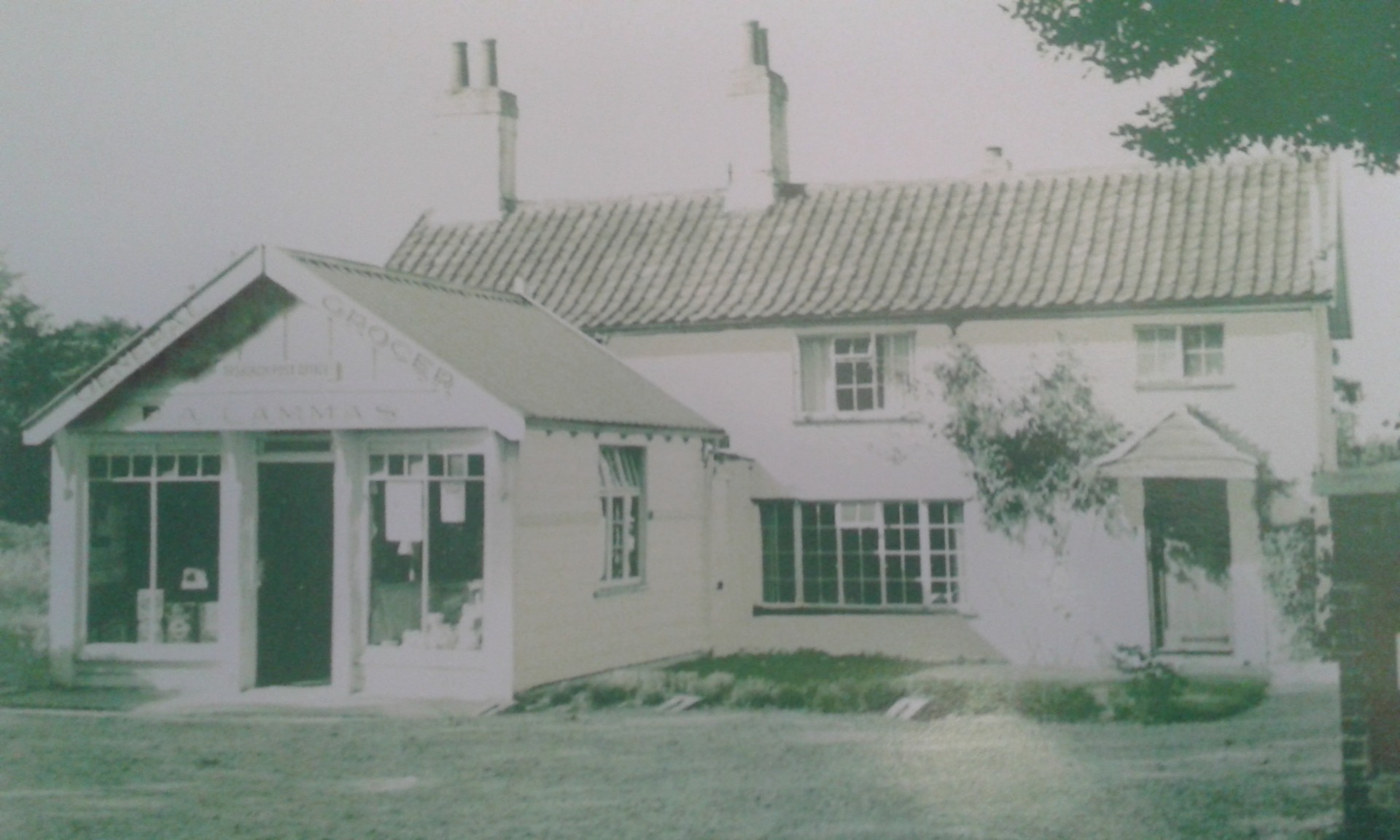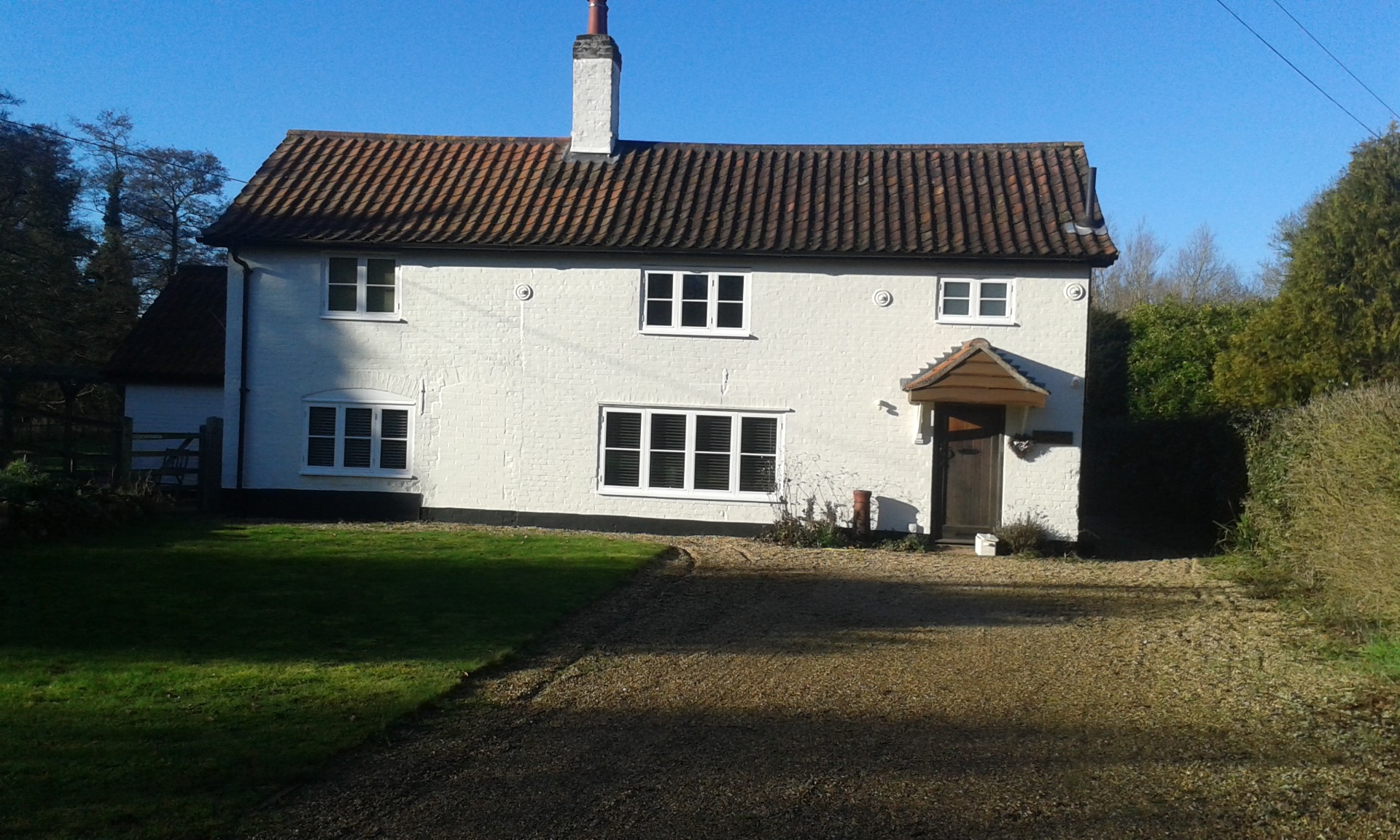Commerce House, Low Road

In 1791 the property now known as Commerce House was owned and occupied by John Chambers who also owned the adjoining cottages. Indeed it seems clear that the house was built in the garden of what is now Tas Cottage hence its slightly odd position, tight against the original southern boundary and at the head of a drainage ditch to the River Tas. When John Chambers sold the property with the adjoining cottages to Simon Rayson in April 1791 the house was described as a mansion which might indicate that it was recently built, perhaps by John Chambers himself for his own use and occupation.
The new owner, Simon Rayson, who had previously rented a shed on the land from John Chambers, was a wheelwright and blacksmith by trade and he added a blacksmith's shop and a wood turner's shop to the property, presumably in which to make parts for his wheels. At some point in his next 11 years of ownership and whether out of financial necessity, investment or simply to house a relative, Mr Rayson divided the house to create a separate dwelling. By modern standards, that hardly seems possible but it was certainly not uncommon for a family to live in a two room cottage, one down one up with access to a separate earth closet toilet out the back or down the garden.
In May 1801 Simon Rayson sold off the adjoining let cottages, now Tas Cottage and Akela, to John Simmons, a Norwich butcher, as an investment for £105. By then Commerce House had become three cottages occupied by Mary Newson, Henry Sutton and George Points. A year later, Mr Rayson sold the property, also to John Simmons, together with its blacksmith's shop, turner's shop, outhouses, buildings, yard and garden occupied by him and the other part or cottages occupied by two widows, Elizabeth Nichols and Ann Sutton.
In January 1807 John Simmons sold all of the properties he had acquired from Simon Rayson in 1801 and 1802 to Christopher Capon for £212 and ten shillings. Apart from the cottage previously lived in by Mr Rayson which had been let to Stephen Jacobs, the occupants of the other four cottages hadn't changed. Christopher Capon was a Norwich painter and gilder who in due course acquired other properties in Tasburgh. The 1818 Enclosure Award shows him also owning Grove Cottage and a field with two pairs of cottages which originally stood opposite the former council houses on Grove Lane but which were demolished in the late 1800s. For the purchase in 1807 Mr Capon was sent a bill for £9 and two shillings by his solicitor Thomas Blake of Norwich, about a third of which represented the cost of parchment for the documentation.
At a Manorial Court held on 14th November 1804 John Simmons had been granted a licence to enclose 7 rods or perches of land (.044 of an acre) occupied by his tenant Stephen Jacobs, being part of the waste of the Manor of Tasburgh Uphall, for a yearly rent of sixpence, the benefit of which was formally transferred to Christopher Capon in 1808. This would have been a piece of land immediately to the south and forming part of the garden of Commerce House fronting on to the highway. Two years later he was granted a licence to enclose a further adjoining piece of manorial land, also for a yearly payment of sixpence, bringing the total to 20 perches or .125 of an acre and then under the 1818 Enclosure Award Christopher Capon was granted a further 2 roods and 4 perches of adjoining land, just over half an acre, along the road frontage shown as enclosure numbers 28 and part 31 on the 1882 and 1902 editions of the Ordnance Survey map for the village.
Christopher Capon died on 4th August 1844 having by his Will dated 16th February 1843 appointed his daughter Charlotte to be his executor. Unfortunately she died intestate before completing the administration of her father's estate and it was left to William Capon to sort things out after being granted Letters of Administration in 1846. He put the holding up for sale by auction at the Royal Hotel in Norwich on the 7th November that year when it was bought by Thomas Alborough of Trowse Newton for £220, the sale being completed on 14th January 1847. At some point Mr Capon must have further sub-divided the property as it was described in 1847 as previously three cottages with a Weaver's shop, sheds, buildings, yards and gardens previously occupied by Stephen Jacobs, George Simmons and Rebecca Meadows but then occupied as two by John Minns and Richard Warnes, who had been there at the time of the 1841 census and was described as a shoemaker. From the description of the boundaries it is also clear that Mr Capon must have sold off the two adjoining cottages to the North before his death to Ephraim Frances. That must have been after 1840 because in the Tithe Apportionment that year he was still recorded as owning the two sets of cottages.
Thomas Alborough died on 26th February 1863 and under the terms of his Will dated 8th September 1860 his son John, an attorney's clerk, was appointed to be his sole executor. Under the Will he held the property for the benefit of his mother Martha and following her death on 2nd February 1865 he put his father's properties up for sale by auction, again at the Royal Hotel, on 16th June 1865. Lots 5 and 6 being the property bought from Christopher Capon didn't find a buyer but was subsequently sold to Robert Harris, a railway clerk from Stratford in Essex for £240. By the 1871 census occupation of the property had passed to William G Duffield, a lime burner by trade, who ran the lime kilns at the Tharston brickworks. He was the father of William Lant Duffield who took on the tenancy of Tasburgh Mill in 1896 and, together with his sons, was the founder of the Duffield milling business. The 1881 and 1891 census returns however show the property as occupied by agricultural workers, firstly James Pigg and his wife Amelia and then Edward and Mary Harwin.
Robert Harris died on 16th November and under his Will dated 23rd March 1893 he left the property to the Rev. William Backhouse Gowan from Shropshire so possibly a relative, as trustee for his infant orphaned daughters Charlotte Mary Harris and Beatrice Harris, charged with their maintenance, education and support. On 22nd March 1899 the Rev. Gowan was succeeded as trustee by the Rev. Benjamin Waugh, a director of the NSPCC, living in London, and Agnes Ida Tompkins from Sparkbrook in Birmingham. At that time the property was described as a single cottage (previously three cottages and afterwards two cottages) let to Mrs M. A. Harwin, Edward Harwin having presumably died by then. The Rev. Waugh died in March 1908 and in November that year the surviving trustee, Mrs Tomkins, then a widow living in St. Bees Cumberland, acquired for £4 eleven pence from the Manor of Tasburgh Uphall with Boylands and Hunts the freehold title to all the copyhold land following which on 30th January 1909 she transferred the entire property to the two adult daughters of Robert Harris.
It is not known exactly when John Abraham Lammas took on the tenancy of the property in succession to Mrs Harwin, but he and his family were shown as living there at the time of the 1901 census. On 21st April 1920 he was able to buy the freehold from Charlotte and Beatrice Harris who were still living in London for £360 with the help of a mortgage of £250 from a Mrs Eleanor Mary Carman. The property was then described as a shop and dwelling house. The shop was a wooden building attached to the southern or left hand end of the front of the house facing the road and had probably been added by Mr Lammas himself. A few months later, in June that year he had to borrow a further £80 from his solicitors, Cozens- Hardy and Jewson in Norwich on a second or equitable charge.
On 17th May the first charge to Mrs Carman was replaced with another mortgage for £255 to Cozens-Hardy and Jewson and then on 20th March 1941 Mr Lammas transferred the property subject to the two charges to his son Philip when they were respectively referred to as a Grocer and Draper and a Grocer and Draper's assistant. In 1954 Philip Lammas took over the position of village postmaster on the retirement of Mr Ellis who lived at Old Post Office Cottage on the corner of Low Road and Flordon Road. He also rented the former stone pit, now Burrfeld Park opposite Commerce House, and the marshes adjoining the house from the trustees of Tasburgh United Charities on which he built some sheds to raise chickens and produce eggs for sale to supplement the shop business, and was finally able to pay off the two mortgages in 1964.
In 1978 Mr Lammas sold to Barry Kelvin Mulcahy the majority of the land originally granted to Mr Capon under the 1818 Enclosure Award and on part of it Mr Mulcahy built a house for himself, now known as Sweetlands. After Philip's death on 5th March 1979, his widow Jean Parker Lammas continued to run the shop for a while but after the post office moved to Church Road, she closed the shop and the wooden building was taken down. The outline of the doorway connecting the house to the shop can still be seen in the brickwork and may well have dated back to the time when the building was more than one dwelling. To the left, by the road there was a red public telephone box, and the forecourt was used for many years as a stopping point for the Simonds bus service to Norwich or to Long Stratton and Diss.
Mrs Lammas moved into care before dying in 2012 and the house stood empty until her executors sold the house and garden to Amanda Emma Cook in 2014 but the family retained some of the land fronting onto the road as a potential future building plot. Amanda Cook also purchased a piece of the adjoining marsh from Tasburgh United Charities and then renovated and extended the house adding a new open plan kitchen and living area with doors on to a large patio area at the back and views over the enlarged garden down to the river. With the house Amanda received a full set of original title deeds dating back to 1791 on which this note has been largely based.
